Mindfulness practices offer effective strategies for stress reduction and enhanced focus. These techniques include meditation, deep breathing, and body scanning, which promote relaxation and emotional regulation. Regular practice fosters self-awareness and resilience to stressors. Additionally, unique attributes like biofeedback and nature immersion can further enhance their effectiveness.
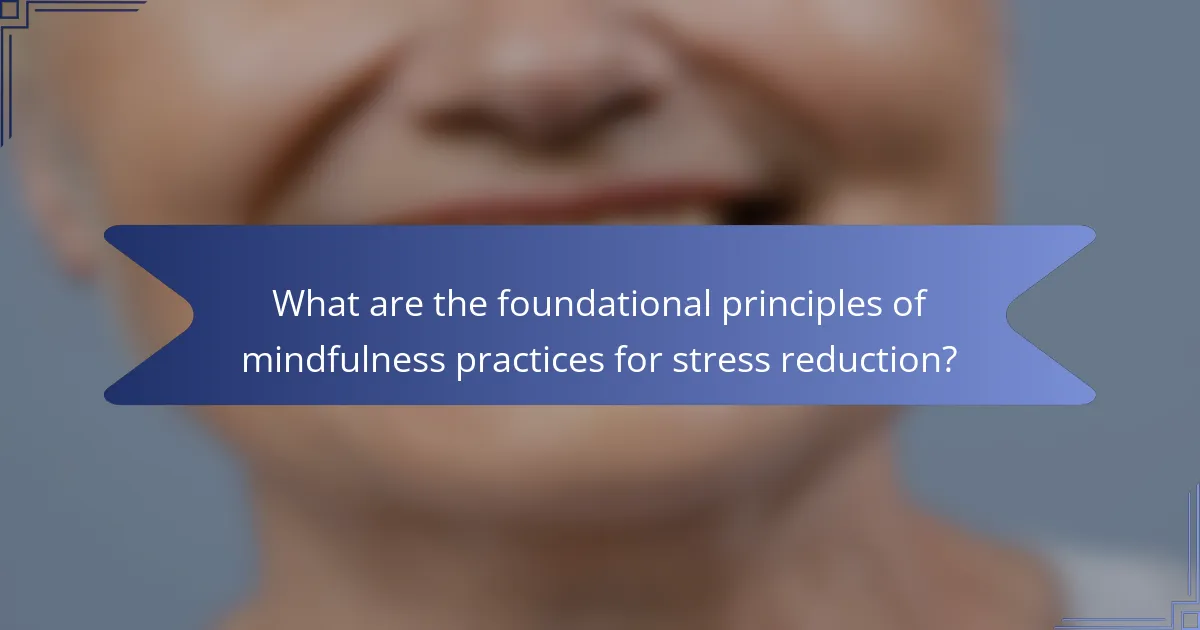
What are the foundational principles of mindfulness practices for stress reduction?
Mindfulness practices for stress reduction are grounded in principles that enhance self-awareness and promote relaxation. Key foundational principles include focused attention, acceptance, and non-judgmental observation. Focused attention involves directing awareness to the present moment, which reduces distractions and anxiety. Acceptance encourages individuals to acknowledge their thoughts and feelings without resistance, fostering emotional resilience. Non-judgmental observation allows practitioners to experience their thoughts and sensations without labeling them as good or bad, which can lead to reduced stress and improved mental clarity. These principles collectively enhance focus and emotional well-being.
How does mindfulness impact stress levels?
Mindfulness practices significantly reduce stress levels by promoting relaxation and enhancing focus. Techniques like meditation and deep breathing activate the body’s relaxation response, lowering cortisol levels and improving emotional regulation. Research shows that regular mindfulness practice can decrease anxiety and improve overall well-being. For instance, a study found that participants who practiced mindfulness reported a 30% reduction in perceived stress after eight weeks. Incorporating mindfulness into daily routines can lead to lasting positive effects on mental health.
What are the cognitive benefits of enhanced focus through mindfulness?
Mindfulness practices enhance focus, leading to improved cognitive benefits. These benefits include increased attention span, better memory retention, and enhanced problem-solving skills. Studies show that mindfulness training can significantly boost cognitive flexibility, allowing individuals to adapt to new information more effectively. Regular mindfulness practice can also reduce mental clutter, promoting clearer thinking and improved decision-making.
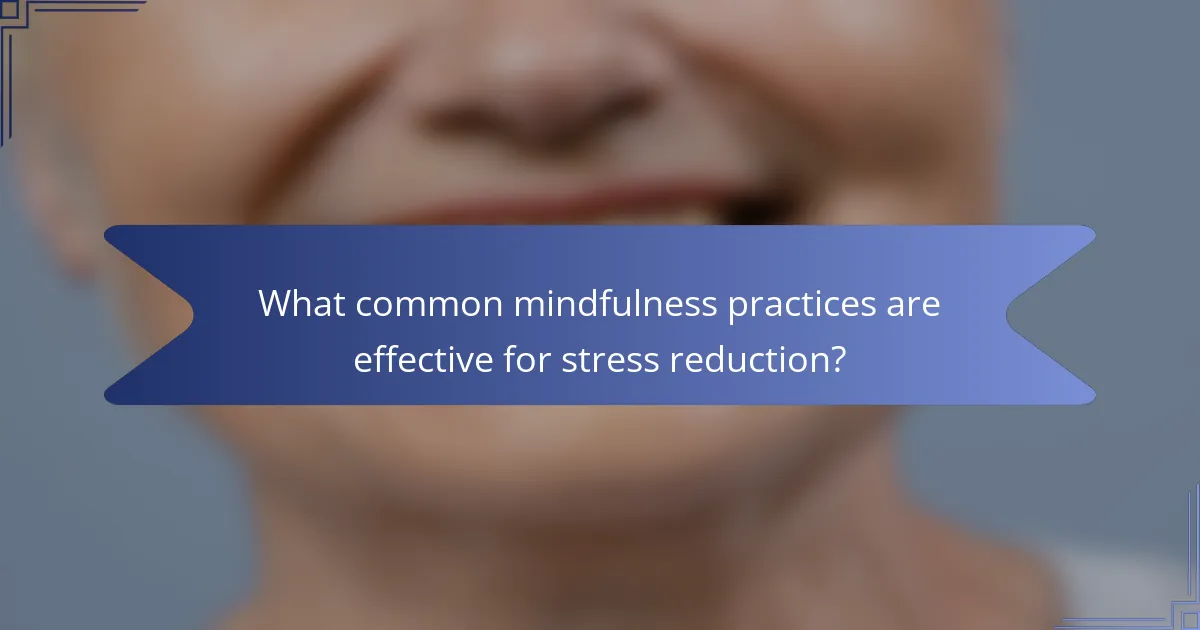
What common mindfulness practices are effective for stress reduction?
Mindfulness practices such as meditation, deep breathing, and body scanning effectively reduce stress and enhance focus. These techniques promote relaxation, increase self-awareness, and improve emotional regulation.
Meditation involves focusing attention and eliminating distractions, which can lead to a decrease in stress levels. Deep breathing exercises help activate the body’s relaxation response, lowering heart rate and calming the mind. Body scanning encourages awareness of physical sensations, allowing individuals to release tension and stress.
Regular practice of these mindfulness techniques can lead to long-term benefits, including improved concentration and resilience to stressors. Research indicates that consistent mindfulness practice can enhance overall mental health and well-being.
Which mindfulness techniques are widely used for stress relief?
Mindfulness techniques widely used for stress relief include meditation, deep breathing, body scan, and mindful walking. These practices enhance focus and promote relaxation.
Meditation focuses attention and reduces anxiety. Deep breathing regulates the body’s response to stress. Body scan involves paying attention to physical sensations, fostering awareness. Mindful walking encourages connection with the environment, promoting a sense of calm.
Incorporating these techniques regularly can significantly lower stress levels and improve overall well-being.
What role does breath awareness play in mindfulness?
Breath awareness is fundamental in mindfulness as it anchors attention and promotes relaxation. By focusing on breathing, individuals cultivate present-moment awareness, reducing stress and enhancing concentration. This practice fosters a unique connection to one’s body, allowing for deeper emotional regulation and mental clarity. Regular breath awareness can lead to significant improvements in overall well-being.
How can body scanning techniques reduce tension?
Body scanning techniques effectively reduce tension by promoting awareness of bodily sensations and facilitating relaxation. This mindfulness practice helps individuals identify areas of stress, allowing them to consciously release tension. As a result, practitioners experience enhanced focus and emotional clarity. Studies show that regular body scanning can lead to significant reductions in anxiety and stress levels, contributing to overall well-being.
What are the most popular mindfulness exercises for improving focus?
Mindfulness exercises for improving focus include meditation, body scanning, mindful breathing, and mindful walking. These practices enhance concentration and reduce distractions.
Meditation promotes mental clarity by training the mind to focus on a single point of reference. Body scanning encourages awareness of physical sensations, fostering a deeper connection to the present moment. Mindful breathing helps regulate emotions and enhances attention span. Mindful walking combines movement with awareness, grounding individuals in their environment.
Regular practice of these exercises can lead to significant improvements in focus and overall mental well-being.
How does mindful observation enhance concentration?
Mindful observation significantly enhances concentration by promoting awareness of the present moment. This practice reduces distractions and increases focus, allowing individuals to engage fully with their tasks. Studies show that regular mindfulness practices can lead to improved cognitive function and attention span. By training the mind to observe thoughts without judgment, individuals can cultivate a clearer mental state, which supports sustained concentration.
What is the significance of mindful walking?
Mindful walking significantly enhances focus and reduces stress. This practice encourages awareness of each step, promoting a connection between body and mind. Research indicates that mindful walking can lower anxiety levels and improve emotional regulation. Regular engagement in this practice fosters a sense of calm and presence, ultimately benefiting mental health.
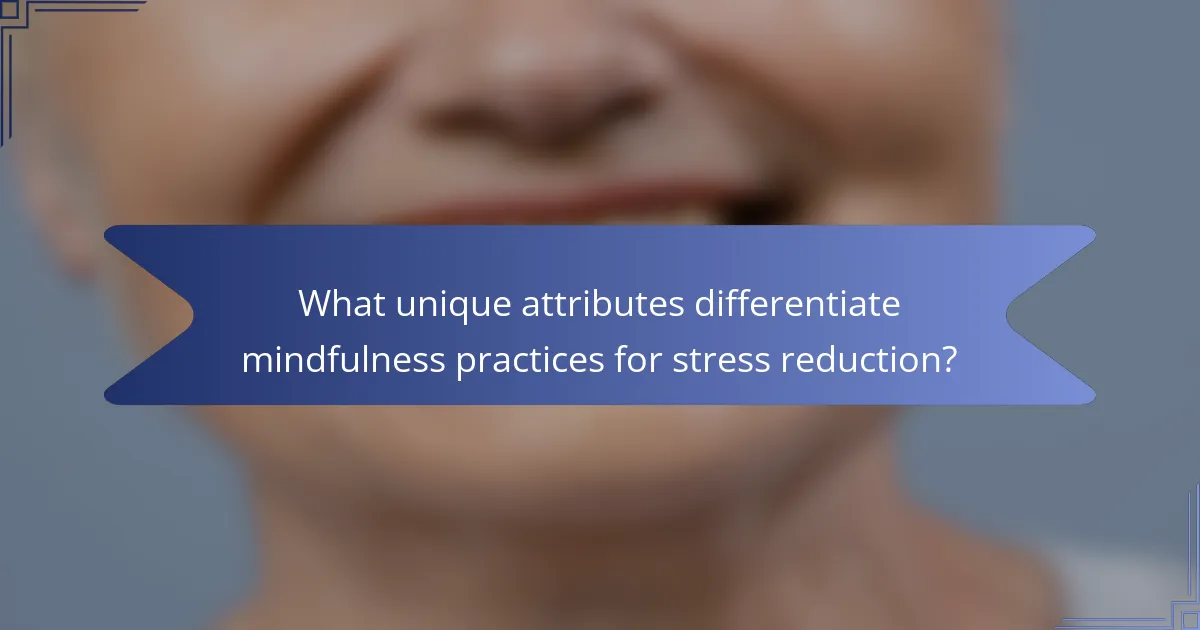
What unique attributes differentiate mindfulness practices for stress reduction?
Mindfulness practices for stress reduction are distinguished by their unique attributes such as focus on present awareness, non-judgmental observation, and integration into daily routines. These practices enhance emotional regulation and promote resilience. Techniques vary, with some emphasizing breath control while others incorporate movement or guided imagery. The adaptability of these practices allows individuals to tailor their approach, making mindfulness accessible to diverse lifestyles and preferences.
How does the integration of technology enhance mindfulness practices?
The integration of technology enhances mindfulness practices by providing accessible tools and resources. Apps and wearables offer guided meditations, reminders, and progress tracking, making it easier to incorporate mindfulness into daily routines. These tools can personalize experiences, adapting to individual needs and preferences. Additionally, virtual reality environments create immersive experiences that deepen relaxation and focus, demonstrating a unique application of technology in mindfulness.
What role do cultural variations play in mindfulness techniques?
Cultural variations significantly influence mindfulness techniques by shaping practices and perceptions. Different cultures emphasize unique aspects of mindfulness, such as community involvement, spirituality, or individual introspection. For example, Eastern traditions often incorporate meditation and breath control, while Western approaches may focus on cognitive behavioral techniques. These variations enhance the adaptability of mindfulness practices, allowing individuals to select methods that resonate with their cultural backgrounds. This cultural diversity enriches the overall effectiveness of mindfulness for stress reduction and enhanced focus.
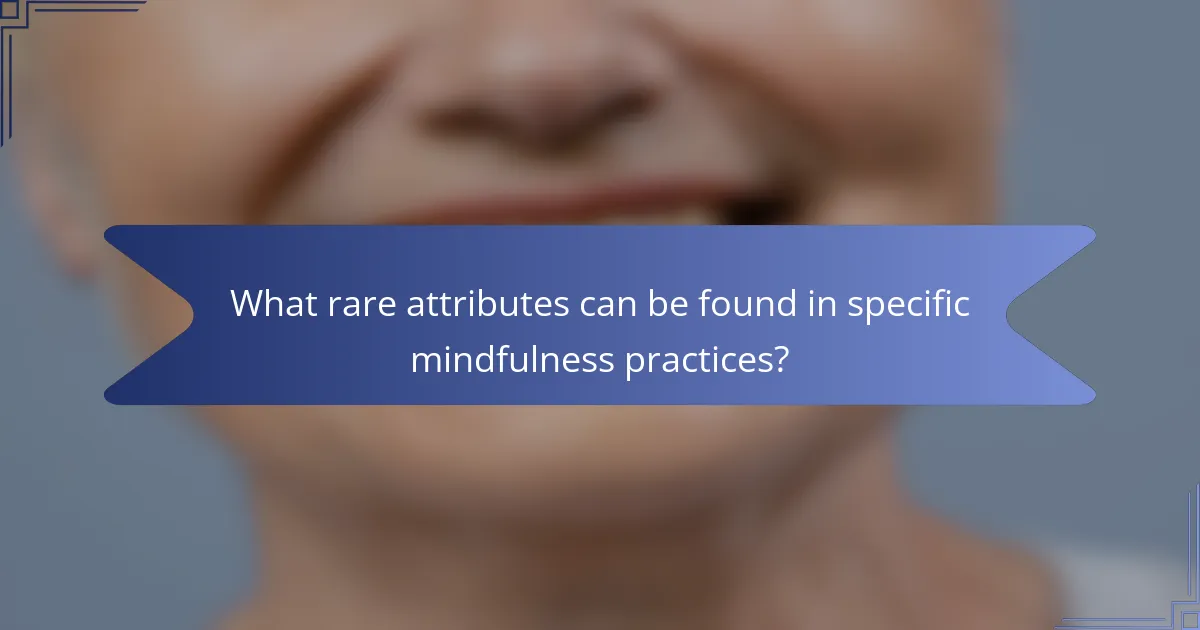
What rare attributes can be found in specific mindfulness practices?
Certain mindfulness practices exhibit rare attributes that enhance their effectiveness for stress reduction and focus. For instance, some techniques incorporate biofeedback, allowing practitioners to visualize physiological responses, which can deepen self-awareness. Additionally, specific practices may combine elements of sound therapy, using unique frequencies to promote relaxation. Others might integrate nature immersion, where participants engage in mindfulness outdoors, leveraging the calming effects of natural environments. These rare attributes can significantly differentiate mindfulness practices, providing unique benefits that enhance their overall impact.
How do personalized mindfulness programs address individual stressors?
Personalized mindfulness programs effectively target individual stressors by tailoring techniques to specific needs. These programs assess unique stress triggers and adapt practices like meditation, breathing exercises, and guided imagery accordingly. As a result, users experience improved emotional regulation and focus. Research indicates that personalized approaches can enhance engagement and lead to more significant stress reduction compared to generic programs. This adaptability is a unique attribute that sets personalized mindfulness apart, ensuring relevance and efficacy for each individual.
What unique approaches exist in mindfulness for specific demographics?
Mindfulness practices can be tailored to specific demographics for optimal stress reduction and focus enhancement. For instance, children benefit from playful mindfulness techniques like mindful breathing games, which enhance attention and emotional regulation.
Teenagers may prefer technology-integrated mindfulness apps that offer guided meditations, addressing their unique stressors related to academic pressure and social dynamics.
Adults often engage in structured programs such as Mindfulness-Based Stress Reduction (MBSR), which provide comprehensive approaches to manage work-related stress and improve cognitive function.
Senior individuals may find value in gentle mindfulness practices like tai chi, which promote physical health and mental clarity, catering to their specific mobility and health considerations.

What regional variations influence the adoption of mindfulness practices?
Regional variations significantly influence the adoption of mindfulness practices. Cultural beliefs, societal norms, and accessibility to resources shape how mindfulness is perceived and practiced.
In Asia, mindfulness often integrates with traditional practices like meditation and yoga, emphasizing spiritual growth. In Western countries, the focus tends to be on stress reduction and mental health benefits.
Economic factors also play a role; regions with higher disposable incomes may have more wellness centers offering mindfulness courses. Conversely, in lower-income areas, community programs may promote mindfulness as a free or low-cost resource.
Finally, educational systems influence mindfulness adoption. Schools that incorporate mindfulness into curricula foster early acceptance, while regions that overlook it may see slower integration.
How do cultural attitudes shape mindfulness practices for stress relief?
Cultural attitudes significantly influence mindfulness practices for stress relief by shaping techniques and perceptions. In cultures emphasizing collectivism, mindfulness may incorporate community and relational aspects, enhancing social support. Conversely, individualistic cultures often focus on personal achievement and self-awareness, leading to practices centered on individual meditation and introspection. These differences illustrate how cultural values dictate the integration of mindfulness into daily life, affecting its effectiveness and acceptance. Understanding these cultural nuances can enhance the application of mindfulness for diverse populations, promoting greater stress relief and improved focus.
What local adaptations enhance focus through mindfulness?
Local adaptations enhancing focus through mindfulness include practices tailored to cultural and environmental contexts. Techniques such as nature immersion in parks or community gardens foster tranquility and concentration. Group mindfulness sessions in local settings promote social connection, enhancing focus. Incorporating traditional practices, like Tai Chi or yoga, aligns mindfulness with local customs, reinforcing mental clarity. Additionally, using local sounds, like nature or community activities, during mindfulness exercises can deepen engagement and focus.
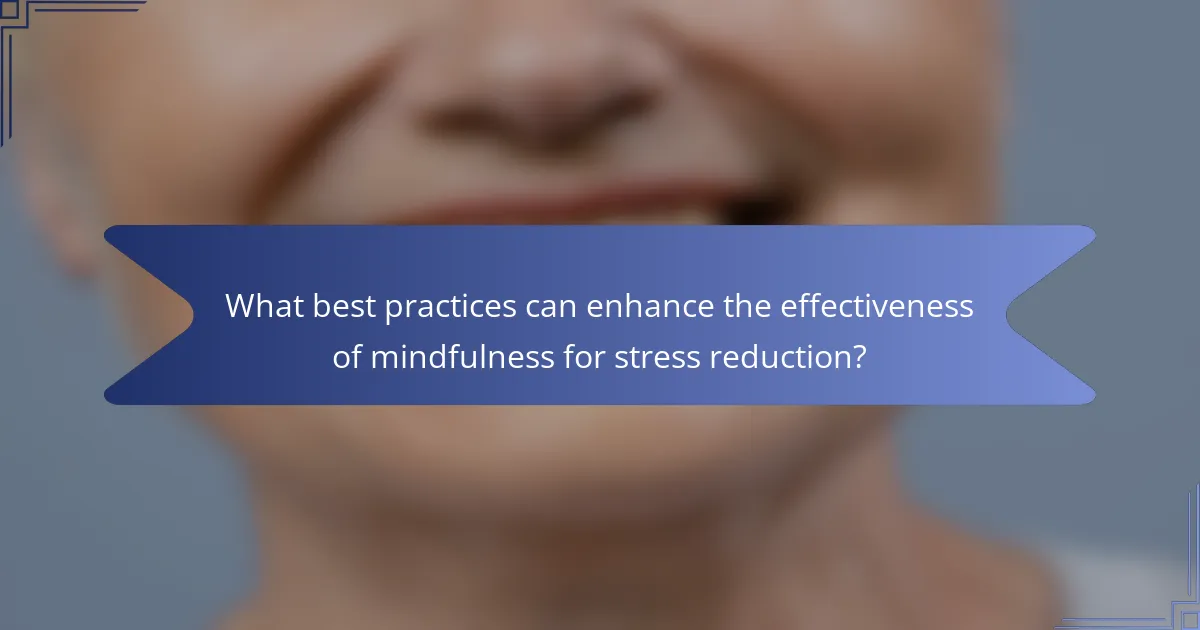
What best practices can enhance the effectiveness of mindfulness for stress reduction?
Mindfulness practices enhance stress reduction by promoting awareness and focus. Key best practices include regular meditation sessions, deep breathing exercises, mindful walking, and journaling. Consistent practice can lead to improved emotional regulation and decreased anxiety levels. Engaging in group mindfulness sessions can also provide support and accountability, enhancing overall effectiveness.
How can individuals create a consistent mindfulness routine?
To create a consistent mindfulness routine, individuals should establish a daily practice that incorporates specific techniques. Begin with short sessions, gradually increasing duration as comfort grows.
1. Set a specific time each day for mindfulness.
2. Choose a quiet space free from distractions.
3. Practice deep breathing or guided meditation.
4. Incorporate mindfulness into daily activities, like eating or walking.
5. Reflect on experiences in a journal to track progress.
Consistency is key to experiencing the benefits of mindfulness, such as reduced stress and improved focus.
What common mistakes should be avoided in mindfulness practice?
To enhance mindfulness practice, avoid common mistakes that hinder progress. Neglecting consistency can diminish benefits. Focusing too much on outcomes rather than the process can create frustration. Skipping foundational techniques, such as breath awareness, may lead to ineffective practice. Lastly, comparing your journey to others can create unnecessary pressure.
What expert tips can maximize the benefits of mindfulness for stress and focus?
To maximize the benefits of mindfulness for stress reduction and enhanced focus, practice regularly, even for short periods. Incorporate deep breathing techniques to anchor your attention. Set specific intentions for each session to enhance clarity. Use guided meditations to maintain focus and structure. Create a distraction-free environment to deepen your practice. As a result, these strategies can lead to improved emotional regulation and cognitive performance.